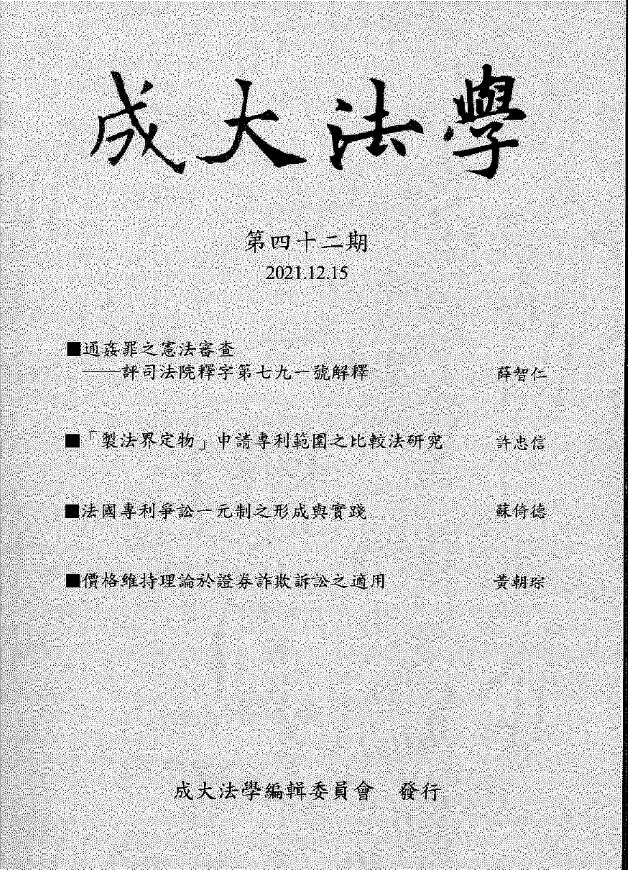前期出版
前期出版
頁數:71﹣106
「製法界定物」申請專利範圍之比較法研究
A Comparative Research on Product-by- Process Claims
研究論文
作者(中)
許忠信
作者(英)
Chung-Hsin Hsu
關鍵詞(中)
專利、申請專利範圍(請求項)、物之發明、方法發明、製法界定物、說明書、專利申請程序、專利侵害
關鍵詞(英)
patent, claim, product claim, process claim, product-by- process, specification, patent prosecution, patent infringement
中文摘要
專利權原來主要乃被用在工業製造領域。當時之發明皆能以產品之結構、物理特性、化學性質或其他可測量之特徵來加以描 述。隨著工業之概念擴及化學、生醫及生物科技領域之後,漸漸 有些發明之產品未能以其結構、物理或化學等特徵來加以界定。 因此,申請專利範圍(claim)除物之發明與方法發明外,需另有「製法界定物(product-by-process)」型的申請專利範圍。
製法界定物申請專利範圍在賦權與維權程序(審查、舉發與無效程序等)之處理上國際差異性較低,但在侵權程序之效力上,美國、德國及日本有不同之法律發展。此一結果,值得我國參考,因此,宜分別介紹之。
製法界定物申請專利範圍之處理在賦權與維權程序較有國際一致性,不論美國、日本、德國皆將其歸屬為絕對物之保護。因此,其可專利性要件符合與否,並非依該製造方法是否符合專利之要件,而是該產品本身須符合專利之要件規定。
然而,製法界定物申請專利範圍在侵權程序則無國際一致性:美國多數判決對其採取一受該製造方法限制之解釋,而僅給其相對之保護;德國與日本法則多數認為其乃一絕對物之保護。
本文於比較研究後建議,在我國法上當專利申請人非自願地或無其他選擇彈性地以製法界定物申請專利範圍來申請專利時,由於其乃屬不得已之例外,專利權人之利益較應受保障,因此,可認為其具有物之發明之絕對保護效力。德國法與日本法即反映 此一思維。當申請人自願地或有選擇彈性地以製法界定物申請專利範圍來申請專利時,則其在侵權程序僅可享有相對之保護(亦即其保護範圍應受其製造方法之限制),以保障第三人之交易安全,因為此時專利權人較無受保護之必要性。
製法界定物申請專利範圍在賦權與維權程序(審查、舉發與無效程序等)之處理上國際差異性較低,但在侵權程序之效力上,美國、德國及日本有不同之法律發展。此一結果,值得我國參考,因此,宜分別介紹之。
製法界定物申請專利範圍之處理在賦權與維權程序較有國際一致性,不論美國、日本、德國皆將其歸屬為絕對物之保護。因此,其可專利性要件符合與否,並非依該製造方法是否符合專利之要件,而是該產品本身須符合專利之要件規定。
然而,製法界定物申請專利範圍在侵權程序則無國際一致性:美國多數判決對其採取一受該製造方法限制之解釋,而僅給其相對之保護;德國與日本法則多數認為其乃一絕對物之保護。
本文於比較研究後建議,在我國法上當專利申請人非自願地或無其他選擇彈性地以製法界定物申請專利範圍來申請專利時,由於其乃屬不得已之例外,專利權人之利益較應受保障,因此,可認為其具有物之發明之絕對保護效力。德國法與日本法即反映 此一思維。當申請人自願地或有選擇彈性地以製法界定物申請專利範圍來申請專利時,則其在侵權程序僅可享有相對之保護(亦即其保護範圍應受其製造方法之限制),以保障第三人之交易安全,因為此時專利權人較無受保護之必要性。
英文摘要
Patents were maily used in manufacuturing indusrties. The inventuon therein could be easily described by physical, chemical and other measurable characteristics of the products. With the extention of the industry concept into the fields of bio-technology and chemestry, some products can not be fully dsscribed by their physical or structural characteristics. As a consequence, patent claims need to have product-by-process type claims in addition to traditional product claims and process claims.
Product-by-process claims are dealt with more equally in patent prosectuion and validity proceedings, but quite differently in infringement proceedings by American, German, and Japanese law. The differences are useful for our reference, so that they are needed to be introduced.
There is, however, an international disagreement in their treatment in infringement proceedings: American law uses the production process to define the product in construing claims, so that it only gives the claim a relative protection. By contrast, German and Japanese law treat product-by-process claims as product claims, so as to give them an absolute protection. That is because American law is more lenient in allowing the use of product-by-process claim in patent prosecutions, but German and Japanese law are more strict in the use of product-by-process claim.
It is submitted that product-by-process claims can be treated as product claims when it is inevitable in their use to apply for patents in Taiwan. When it is only optional or only for convenience sake to use the product-by-process claim to obtain the patent, the patent protection should only be relative, rather than absolute like product claims.
Product-by-process claims are dealt with more equally in patent prosectuion and validity proceedings, but quite differently in infringement proceedings by American, German, and Japanese law. The differences are useful for our reference, so that they are needed to be introduced.
There is, however, an international disagreement in their treatment in infringement proceedings: American law uses the production process to define the product in construing claims, so that it only gives the claim a relative protection. By contrast, German and Japanese law treat product-by-process claims as product claims, so as to give them an absolute protection. That is because American law is more lenient in allowing the use of product-by-process claim in patent prosecutions, but German and Japanese law are more strict in the use of product-by-process claim.
It is submitted that product-by-process claims can be treated as product claims when it is inevitable in their use to apply for patents in Taiwan. When it is only optional or only for convenience sake to use the product-by-process claim to obtain the patent, the patent protection should only be relative, rather than absolute like product claims.
線上閱覽
全文下載get_app
1.全文公開下載




